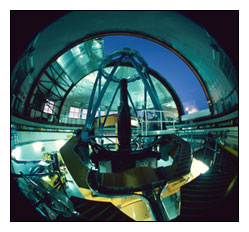EDINBURGH, Scotland, Dec. 30 -- A new astronomical camera is in operation on the United Kingdom Infrared Telescope (UKIRT) in Hawaii. The wide-field camera (WFCAM), built at the UK Astronomy Technology Centre, in Edinburgh, Scotland, is the world's most powerful infrared survey camera. It will survey large regions of the sky at infrared wavelengths and is expected to discover both the nearest objects outside our solar system and the farthest known objects in the universe.

Fisheye lens view of WFCAM at UKIRT with the telescope dome open, at sunset just before the start of a night's observations. (Photo: Paul Hirst, Joint Astronomy Centre)
WFCAM has the largest field of view of any astronomical infrared camera in the world. In a single exposure, it can image an area of the sky equal to that of the full moon.
"The ability to see such a large area at once, with state-of-the-art detectors, makes WFCAM the fastest infrared survey instrument in the world, bar none." said Andy Adamson, head of operations for UKIRT.
WFCAM detects infrared light, or heat radiation, which is the key to understanding many types of astronomical objects. These include stars in our galaxy and beyond, interstellar clouds, the mysterious "failed stars" known as brown dwarfs and quasars at the edge of the observable universe.
"WFCAM will be used to do surveys of the infrared sky which will detect objects one hundred times fainter than those in the deepest existing surveys. This survey program will take up to seven years to complete and will provide astronomers with a picture of the infrared sky to unprecedented depth," said Paul Hirst, WFCAM instrument scientist at UKIRT.
As part of its commission, led by Hirst and Project Scientist Mark Casali, WFCAM was trained on a region of star formation in the constellation Orion, about 1500 light years from Earth. The full WFCAM image area is 1200 times larger than that covered by UKIRT's previous infrared camera UFTI, and 3600 times larger than that covered by the Hubble Space Telescope's infrared camera NICMOS. The astronomers combined observations with different infrared filters to give a "color" image, showing dramatic clouds of gas and dust in the southern half of the Orion nebula. The images reveal not only the illuminated edges of clouds and filaments, but also thousands of young stars that are otherwise hidden from view at visible light wavelengths by the gas and dust.
At the heart of WFCAM are four detector array. They are similar in concept to the CCD chips in everyday digital cameras but use a mercury cadmium telluride crystal to make them sensitive to infrared radiation rather than visible light. While a typical digital camera may take snapshots containing a few million pixels, WFCAM will map the infrared sky in vast tiles that contain over 250 million pixels each. When WFCAM is scanning the sky, it produces images at a phenomenal rate. In a single night, it will generate over 200 gigabytes of data --- enough to fill over 300 CD-ROM disks.
Although the detector arrays occupy a space not much larger than a compact disc case, the entire WFCAM camera is huge. It is an imposing black cylinder, 5.4 metres (18 feet) long and weighing 1500 kilograms (1.7 tons) and points towards the sky from the telescope's primary mirror.
For more information, visit: www.outreach.jach.hawaii.edu